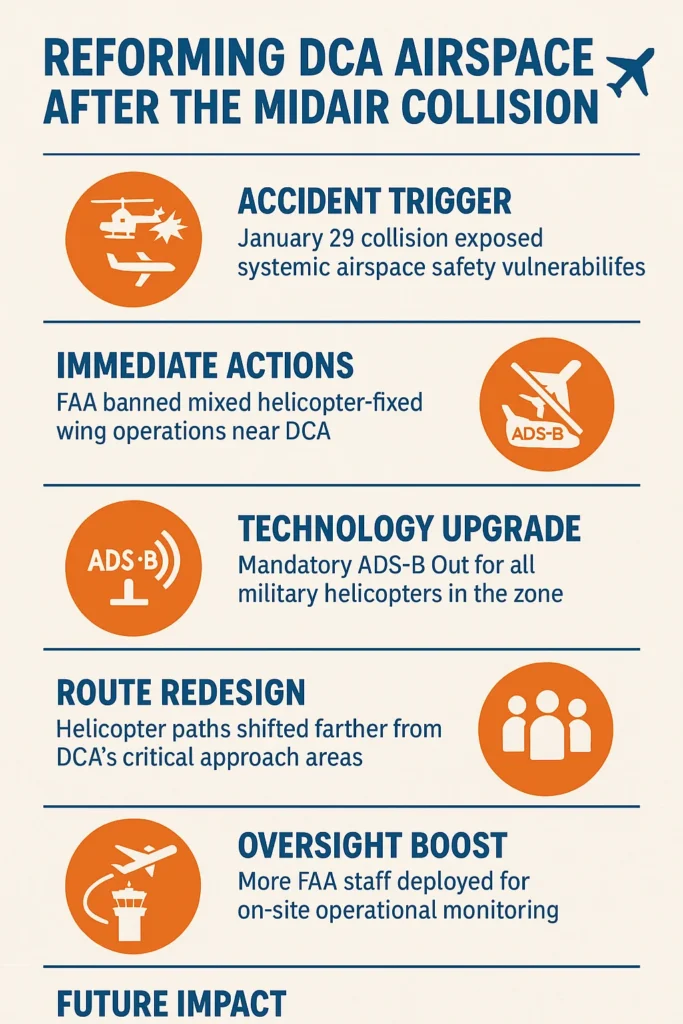FAA implements major safety changes after midair collision at Reagan National Airport early this year, including ADS-B Out for military helicopters and route adjustments.
Midair Collision at Reagan National Airport: Executive Summary
- Accident Trigger: FAA responds to Jan. 29, 2025, midair collision at DCA.
- Immediate Measures: Ended mixed helicopter-fixed wing traffic; revised military agreements for ADS-B Out.
- Airspace Adjustments: Closed Route 4 corridor; shifted helicopter routes farther from DCA.
- Oversight Boost: Increased FAA staffing, eliminated visual separation near the airport.
- Independent Review: Inspector General and NTSB investigations underway, with full FAA cooperation.
FAA’s Statement on Midair Collision at Reagan National Airport

On January 29, 2025, a midair collision over Ronald Reagan Washington National Airport (DCA) shook the U.S. aviation community. In the days and weeks following, the FAA—under the leadership of U.S.
Transportation Secretary Sean P. Duffy and Administrator Bryan Bedford moved swiftly to implement safety reforms. These measures, while local in scope, carry implications for airspace management practices across the nation.
Policy Overview
Issuing Authority: Federal Aviation Administration (FAA)
Announcement Date: August 8, 2025
Core Policy Actions:
1. Airspace Segregation:
The proposal involves the complete and permanent elimination of any mixed traffic between helicopters and fixed-wing aircraft in the vicinity of Ronald Reagan Washington National Airport (DCA).
This measure aims to enhance safety by ensuring that helicopters operate in a designated airspace, free from the complexities and potential hazards of interacting with fixed-wing flights.
2. Route Restrictions:
A significant change will be the closure of the Route 4 corridor, which runs between Hains Point and the Wilson Bridge.
This decision is intended to streamline air traffic management and mitigate congestion in this busy area, thereby improving overall operational efficiency.
3. Military Coordination:
To enhance safety and coordination between military and civilian air traffic, all military helicopters operating in this airspace will be required to broadcast their positions using ADS-B Out technology.
This mandate will ensure that their flight paths are communicated to other airspace users, minimizing the risk of conflicts.
4. Separation Rules:
The existing practices of maintaining visual separation between aircraft will be terminated within a five nautical mile radius of DCA.
This change signifies a shift towards stricter adherence to separation standards, relying more on technological assistance than on visual monitoring.
5. Helicopter Route Modifications:
Helicopter flight paths will be revised to ensure greater distances from the approach and departure routes of the airport.
By adjusting these flight patterns, the aim is to reduce the likelihood of interference with commercial aircraft operations, thereby enhancing safety for all air traffic in the area.
6. Operational Oversight:
The Federal Aviation Administration (FAA) will increase its support staff presence and supervisory activities at DCA.
This heightened level of operational oversight will ensure that air traffic management is more effectively monitored and controlled, contributing to improved safety and efficiency in this crucial airspace.
Background & Context: Midair Collision at Reagan National Airport in January
The January 29 Incident:
A midair collision involving a small general aviation aircraft and a helicopter highlighted vulnerabilities in DCA’s complex airspace.
The proximity to restricted military zones, high-density airline operations, and the Potomac River’s navigational corridor created an operational puzzle that had long challenged controllers.
Historical Precedent:
Reagan National’s airspace has been under scrutiny since the 1981 PATCO strike and subsequent modernization efforts.
Prior conflicts between helicopters and fixed-wing aircraft had been mitigated through procedural agreements. Still, the January 29 collision revealed gaps—especially in visual separation practices and real-time coordination with military flights.
Regulatory Landscape:
- ICAO Annex 11 (Air Traffic Services) emphasizes the separation of air traffic by category.
- FAA Order JO 7110.65 had permitted some visual separation under specific conditions—a policy now restricted at DCA.
- Military coordination agreements pre-dating ADS-B requirements have now been updated to match civil mandates.
Stakeholders & Affected Parties
- Airlines: Major carriers at DCA benefit from reduced complexity in approach sequencing.
- General Aviation Pilots: Will face stricter routing and altitude requirements.
- Military Operations: Impacted by mandatory ADS-B Out broadcasting, enhancing transparency.
- Helicopter Operators: Must adapt to new, longer routes that may increase operating costs.
- Air Traffic Controllers: Gain more apparent operational separation but face transition training requirements.
- Local Authorities: Potential noise footprint changes as helicopters fly farther from urban areas.
Regional vs. Global Effects:
While specific to DCA, these reforms could influence FAA guidance nationwide and serve as a model for congested, mixed-use airports worldwide. ICAO and EASA could consider similar measures in urban mixed-use airspace.
Industry & Expert Reactions
Praise:
The Air Line Pilots Association (ALPA) welcomed the ADS-B requirement for military flights, calling it “a vital transparency step.”
Caution:
The Helicopter Association International (HAI) warned that route changes could push rotorcraft closer to other high-density corridors, creating “new risk vectors if not carefully monitored.”
Regulatory Stance:
FAA Administrator Bryan Bedford stated, “We will not hesitate to take further action if any risk is identified,” underscoring a proactive posture.
Implementation Challenges & Risks
Technical:
Integrating ADS-B Out technology into older military helicopter fleets to enhance real-time tracking and situational awareness, ensuring compatibility with modern airspace management systems.
Operational:
Strategically adjusting air traffic controller staffing levels to accommodate new procedural changes, facilitating smooth operations and minimizing delays during peak traffic periods.
Legal:
Balancing military security requirements with the need for public transparency by implementing Automated Dependent Surveillance–Broadcast (ADS-B), ensuring that sensitive operations remain secure while still providing necessary information to the public.
Coordination:
Effectively managing air traffic flow to maintain safety and efficiency while phasing out traditional visual separation practices that may hinder optimization in busy airspace environments.
Solutions or Best Practices
- Phased Training: Rapid rollout of revised ATC procedures at DCA, supported by simulator training.
- Joint Civil-Military Workshops: To coordinate route design and emergency procedures.
- Noise Monitoring: To assess community impacts of helicopter route changes.

FAA Policy Update on Midair Collision at Reagan National Airport : Outlook
- Safety: There is a promising expectation of a significant decrease in the risks associated with mixed-traffic conflicts at Ronald Reagan Washington National Airport (DCA), enhancing overall safety for both air travelers and ground operations.
- Technology: This initiative could serve as a catalyst for the broader adoption of Automatic Dependent Surveillance–Broadcast (ADS-B) technology in various military-civilian shared airspace environments, potentially improving situational awareness and coordination.
- Policy Spread: Given the success of these measures, it is likely that other busy airports in the United States, such as San Diego International Airport and Honolulu International Airport, might consider implementing similar protocols to alleviate congestion and enhance safety.
Suggestions for Policy Amendments
National ADS-B Mandate for Military Operations:
Extend the existing DCA-specific regulation regarding Automatic Dependent Surveillance–Broadcast (ADS-B) to encompass all airspace utilized by both civil and military aircraft across the country.
This measure aims to enhance tracking and coordination, ensuring safer operations in shared airspace.
Automated Conflict Detection Systems:
Implement advanced AI-driven systems for real-time monitoring of aircraft trajectories in mixed-use approach corridors.
This technology will proactively identify potential conflicts between military and civilian flights, significantly improving safety and operational efficiency.
Public Reporting Portal for Near-Miss Incidents:
Establish a robust public portal that provides detailed monthly reports on near-miss incidents.
By publishing statistics and trends, this initiative aims to foster greater transparency and accountability within the aviation sector, allowing stakeholders to stay informed and engaged in promoting safety.
FAA’s Statement On Midair Collision at Reagan National Airport: Conclusion
The FAA’s swift, decisive action following the Reagan National midair collision illustrates a shift toward proactive, preventive safety governance.
The DCA changes not only address the unique challenges of the capital’s airspace but may set a precedent for how high-density, mixed-use airports around the world manage risk.
For policymakers and industry leaders, this is a reminder that while accidents can spark reform, the goal must be to identify and close safety gaps before tragedy occurs again.
FAQ: Midair Collision at Reagan National Airport
Q1: Why was Route 4 closed to aircraft?
A: It was a busy corridor for both helicopters and fixed-wing aircraft, increasing collision risk.
Q2: How does ADS-B Out improve safety?
A: It provides continuous, real-time aircraft position data to controllers and other pilots.
Q3: Will helicopter noise over residential areas increase?
A: Possibly in some areas, which is why noise monitoring is part of the FAA’s plan.
Q4: Are other airports at risk of similar incidents?
A: Yes—especially those with mixed-use, high-density airspace near urban centers.
Q5: Can these changes delay flights?
A: Some short-term delays are possible during transition, but long-term efficiency is expected to improve.
We Are Going In: The Story of the 1956 Grand Canyon Midair Collision Paperback – April 30, 2017
- By Mike Nelson (Author)
- Rating: 4.6 out of 5 stars (19)
- Language : English
- Print length : 504 pages
” This is the best explanation of the 1956 plane collision over the Grand Canyon that I have ever read. It clarified all of my questions.”
Last update on 2025-08-18 / Affiliate links / Images from Amazon Product Advertising API


